In brief:
- IT leaders outsource help desk more extensively than any other function – making it critical to understand the latest service desk outsourcing trends.
- IT leaders rank proximity as the #1 factor for choosing an outsourced help desk provider – even if a lower cost can be realized in a more distant location.
- Faster resolution and better user experience are top IT service management priorities, with XLAs now outweighing SLAs.
- AI and automation are elevating service desks into strategic business enablers, though skilled talent gaps slow adoption.
- AI-driven swarming accelerates resolution, boosts first-contact fixes, and improves satisfaction for complex cases.
As technology ecosystems grow more complex and AI adoption accelerates, reliable IT support is mission-critical for business continuity. Yet delivering fast, effective help desk service in-house remains more challenging – and costly – than ever.
Understanding the latest service desk outsourcing trends isn’t just helpful – it’s essential for building a resilient, cost-efficient, and future-ready IT support model.
The severe IT labor shortage has stretched IT departments thin, with turnover staying stubbornly high at 13.2% or higher for several years. The average North American help desk agent stays less than 2.5 years and costs $12,000 to replace (Help Desk Institute research).
It’s no wonder help desk has become one of the most frequently outsourced IT functions. Below, we break down the top service desk outsourcing trends you need to know in 2026 – and the best solution for overcoming the IT talent shortage and high cost of labor to gain a high-performing, cost-effective help desk.
1. IT help desk outsourcing is on a growth streak
Help desk outsourcing has grown in leaps and bounds in the last few years. The global help desk outsourcing market is projected to reach $18.3 billion by 2033, up from nearly $10 billion in 2024.
According to the latest IT Outsourcing Statistics Report by Computer Economics, 50% of organizations are already utilizing help desk outsourcing services entirely or in part – more than doubling since 2021. Deloitte’s Global Outsourcing Survey pegs this number even higher, at 65%.
Computer Economics ranks help desk as one of the most outsourced IT functions, along with desktop support and disaster recovery services.
Organizations also outsource help desk more extensively than other IT functions. The average organization outsources 55% of their help desk and desktop support team – claiming the #1 spot by usage level in the Computer Economics report.
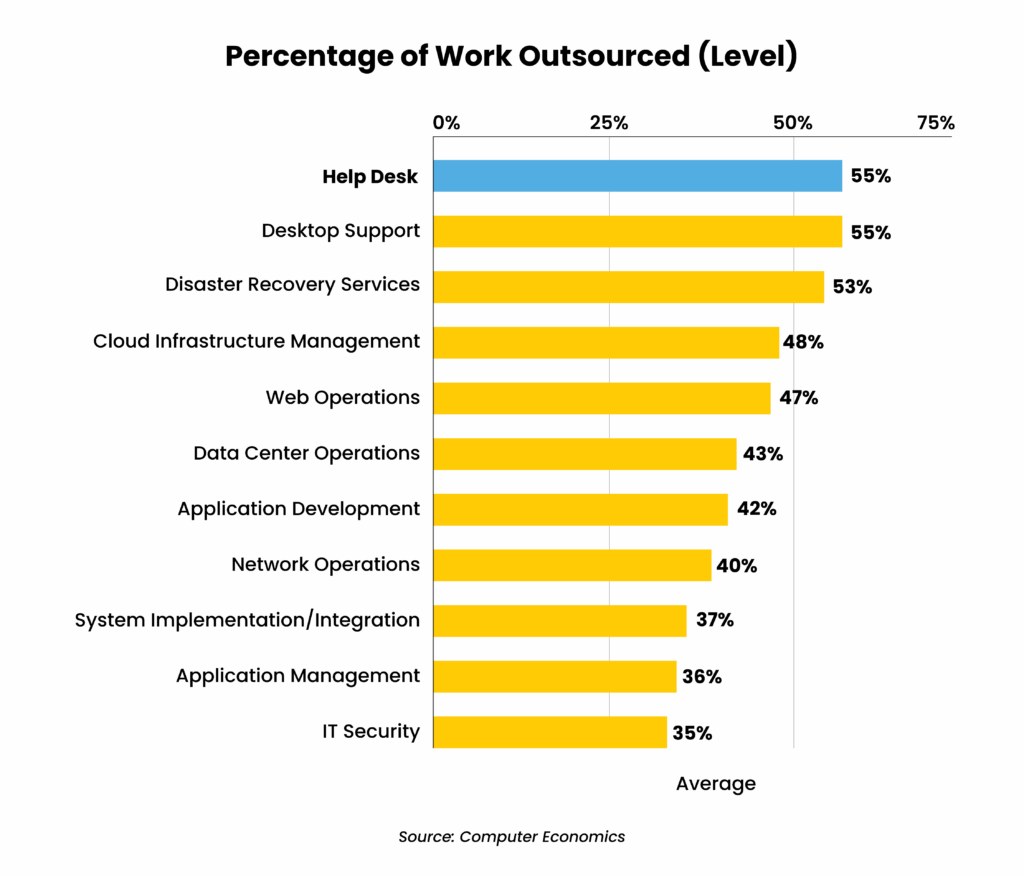
Help desk outsourcing is projected to continue this growth trajectory, with 91% of organizations expecting to either increase (36%) or maintain (56%) the level of work they outsource, and only 9% expecting to reduce it.
The maturity of the IT help desk outsourcing market is a major factor driving the higher usage rate. With well-established, proven solutions, the ease of using external partners compared to the difficulty of developing in-house resources presents a compelling business case.
We’ll touch on other key reasons and drivers for the rise in help desk outsourcing later in this article.
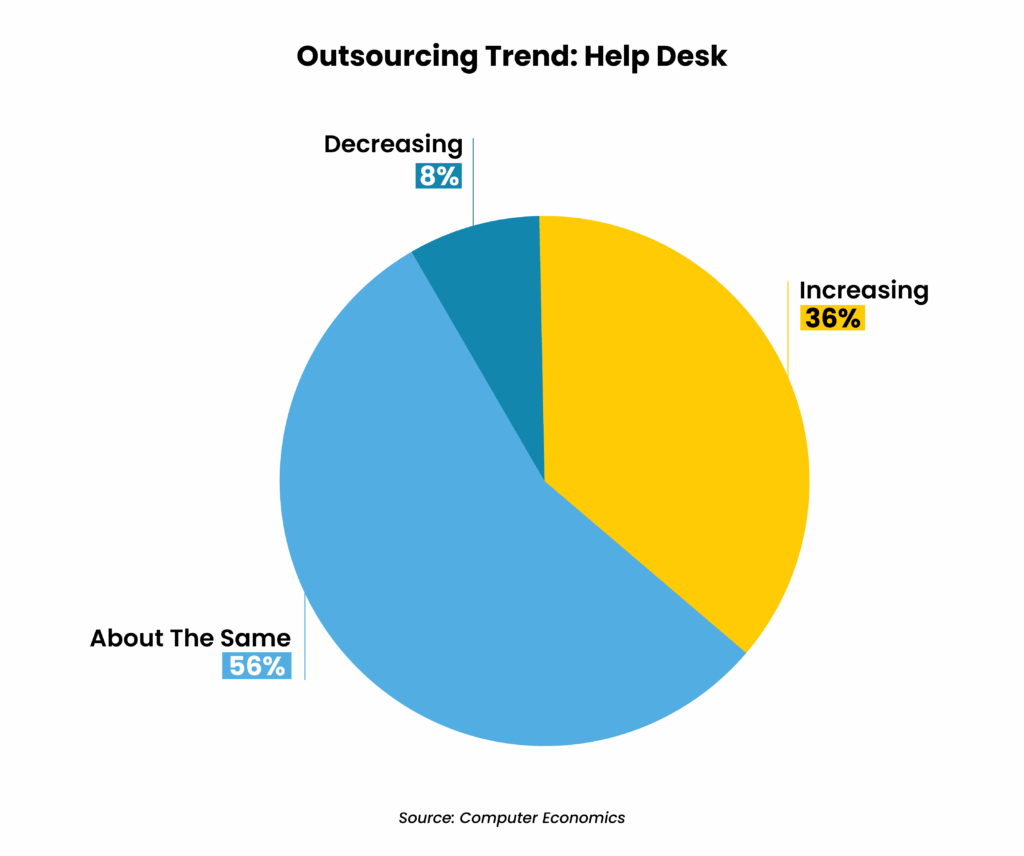
2. Help desk outsourcing is a proven method to reduce costs
As macroeconomic pressures, tariff uncertainties, and technological disruptions grab headlines this year, cost optimization remains a top priority for U.S. enterprises. In this context, help desk outsourcing stands out – delivering the highest cost-success rate of any other IT function.
Computer Economics defines a “successful cost experience” as one in which outsourcing a function costs the same as or less than performing the function in-house.
91% of IT organizations that outsource help desk say their costs are either lower (63%) or the same (28%) as when performing the function in-house.
Computer Economics IT Outsourcing Statistics report
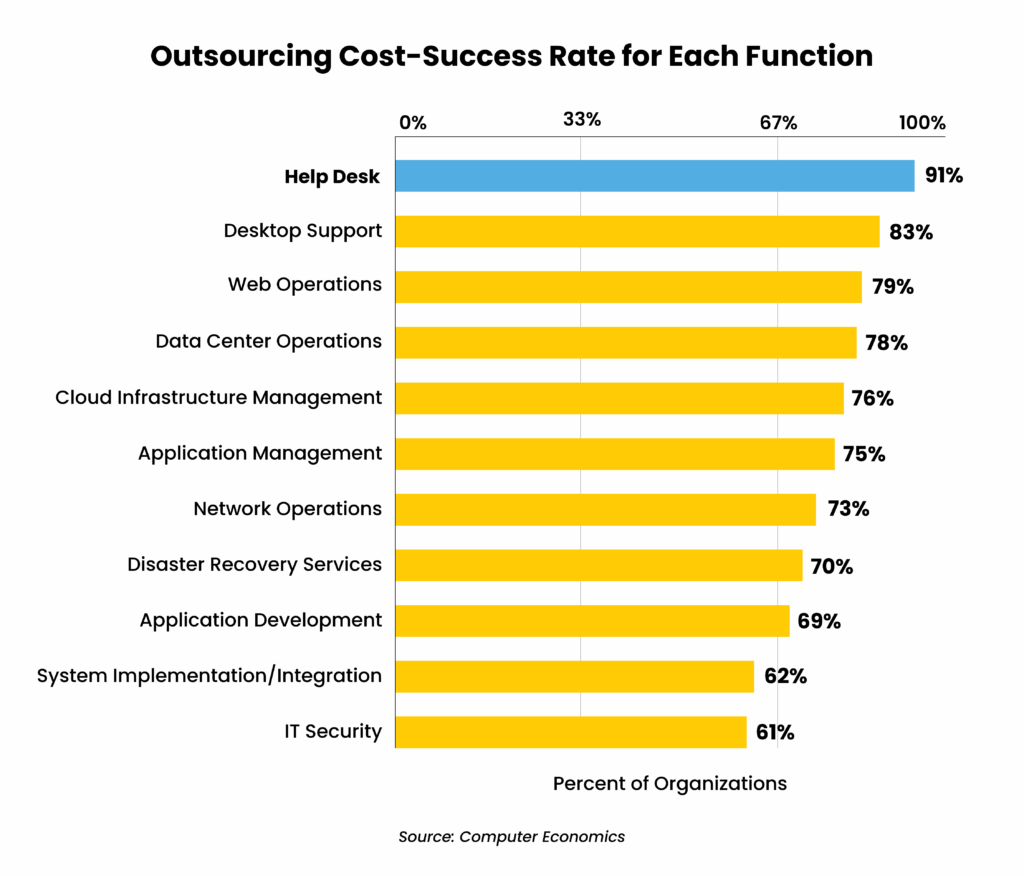
Outsourcing to lower-cost regions, including Latin America and Asia, reduces not only the labor cost but also the indirect cost of in-house recruitment, training, and retention. Quality outsourcing providers also offer flexible pricing models, allowing companies to scale services based on demand.
Best-in-class IT managed services partners further bundle the cost of technology as part of the service, providing the client access to best-in-class service management, contact center, and automation tools and services at a fraction of the price it would cost them to acquire those technologies on their own.
Based on our experience, clients in North America are on average saving 30% to 50% of their help desk labor costs by nearshoring with Auxis. When including the cost of technology and other frequently “hidden” costs, the business case becomes even more compelling.
3. It’s not just about the savings. It’s about improving the service.
On average, office workers give their help desks a “B” grade – not bad, but with plenty of room for improvement (Ivanti’s 2025 Digital Employee Experience Report). Nearly half are frustrated enough to prefer fixing IT problems themselves than contact the help desk, Ivanti found – yet only 13% say it’s “very easy” to do so successfully.
It’s no surprise, then, that employees rank improving the help desk experience as their top IT service priority. Faster issue resolution and better user experience are also the leading goals for IT service management (ITSM) in 2026.
To get there, businesses are shifting toward ITSM solutions that are intuitive and secure – above those that are simply cheaper – to transform help desks from a “good enough” function into a true driver of employee productivity.
SysAid’s The Rise of Agentic AI in ITSM 2025 report
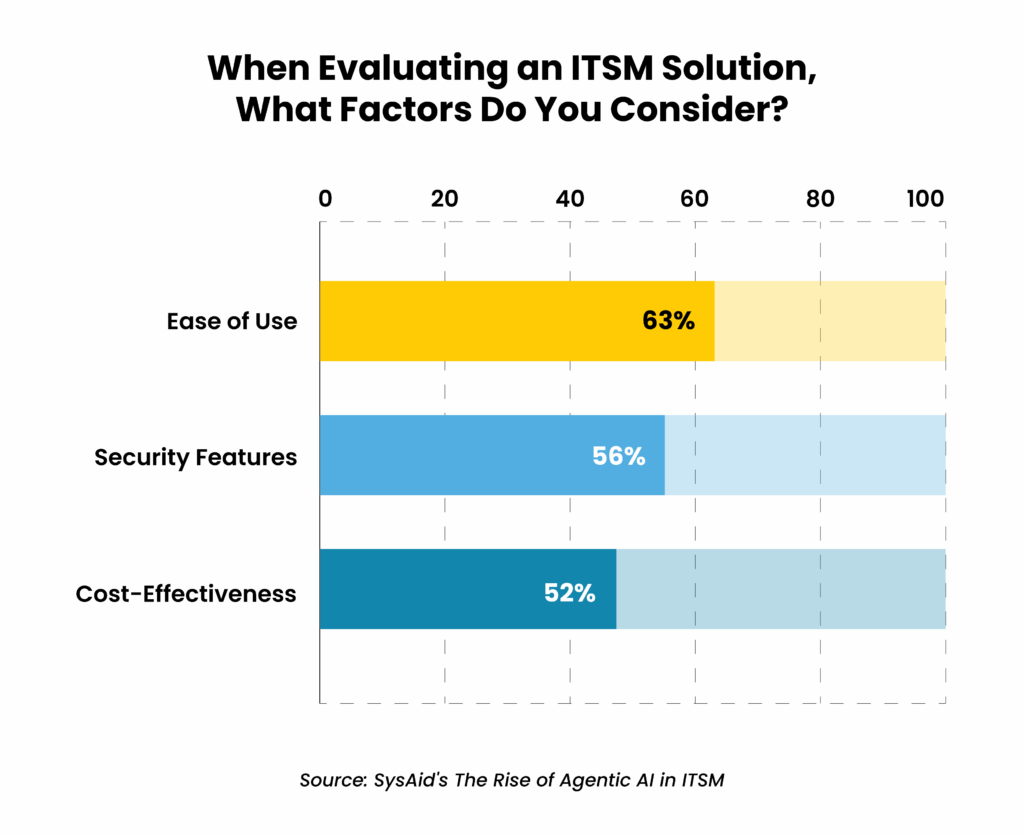
In this environment, businesses are turning to service desk outsourcing to not only lower costs, but to provide better service than they have or could achieve with an in-house solution. Nearly 80% of organizations that outsource help desk consider their service experience to be either “better” or the “same” as when they used to perform the service in-house. Less than a quarter (23%) consider it “worse,” Computer Economics found.
But here’s the thing: While help desk’s 78% service-success rate seems solid, it is actually low compared to other IT functions:
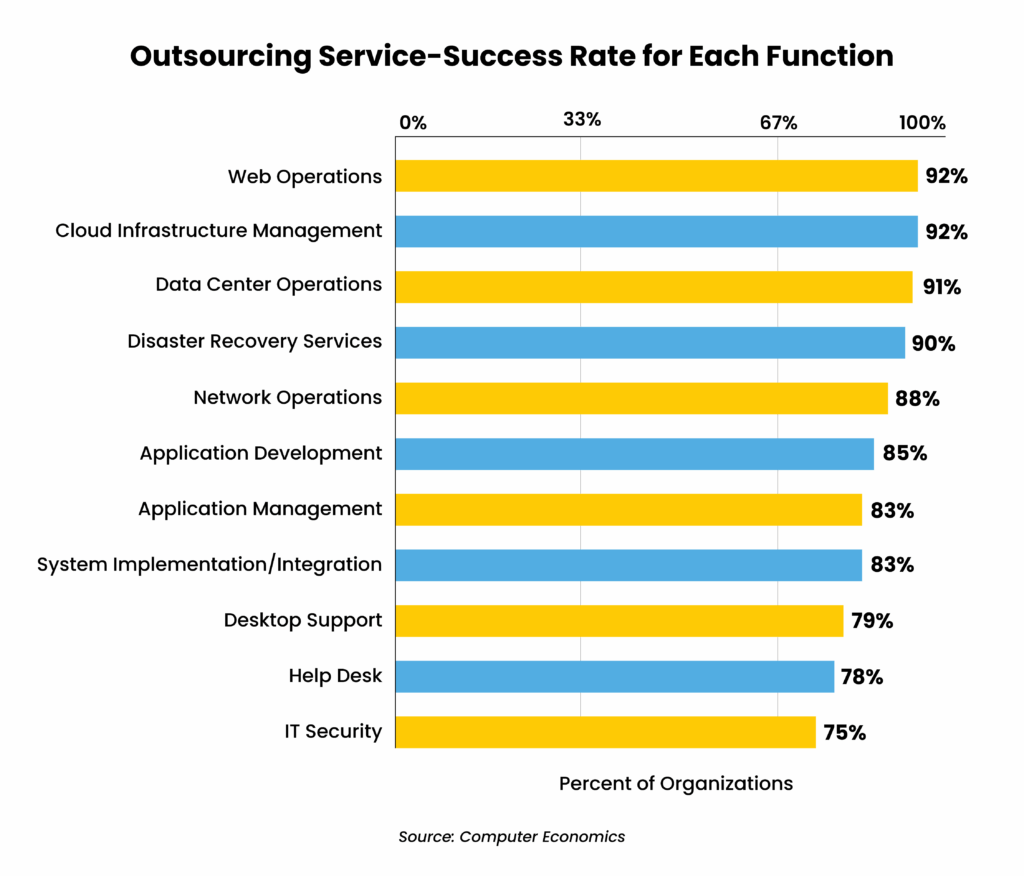
The gap between help desk’s cost reduction and service success emphasizes the importance of choosing an experienced and quality IT help desk outsourcing partner. To maintain bottom-of-the-barrel pricing, some lower-cost outsourcers don’t provide the best practices, highly skilled talent, and digital capabilities needed to create a high-performing service desk.
The help desk is the face of the IT Department for the entire organization, and IT executives need to carefully vet and select a provider that will truly care about the customer experience.
Based on our discussions with CIOs interested in Auxis’ help desk services over the last few years, we are seeing that along with savings, there is a growing preference and demand for:
- Improved, consistent end-user experience
- Expanded coverage hours
- Access to best-in-class AI, automation, performance management, and reporting tools
- Simplified talent management so you don’t have to worry about recruiting, onboarding, training and retention
- Reallocation of internal IT staff towards higher-value, revenue-generating activities
To learn more about outsourcing your help desk for benefits beyond cost savings, check out our blog 6 Outstanding Benefits to Outsourcing Your Help Desk.
4. Automation and AI are key to improving service experience
AI-powered automation is transforming help desks – accelerating the shift from the break-fix model that defined IT support for decades into a strategic enabler of productivity, resilience, and digital experience.
Amid rising ticket volumes, providers are increasingly recognizing the need to deploy AI solutions to speed up issue resolution and enhance efficiency. Adoption is surging, with 80% having at least partially implemented AI in their organization, up from 62% in 2024 (2025 CallMiner CX Landscape Report).
96% of customer experience and contact center providers view AI implementation, including Generative AI and Agentic AI, as a key strategy for success.
2025 CallMiner CX Landscape Report
Chatbots built on script-based automation have taken over many routine service desk tasks: answering frequently asked questions, guiding users through troubleshooting processes, and providing status updates on support tickets. They can manage activities like password resets and software updates without manual intervention, allowing frontline staff to focus on more strategic, high-value processes.
Nearly 70% of employees prefer a self-service option for simple IT issues like password resets, Forrester’s 2024 State of The Service Desk found.
AI is also enhancing knowledge bases, identifying common requests and generating new articles from existing data sources. By enabling a new “Level 0” self-service support tier, these AI-powered tools increase satisfaction by helping employees solve simple problems on their own – reducing ticket volumes, providing faster answers, and enabling 24/7 support without the added cost of staffing after hours.
In a recent blog, Forrester cited organizations resolving 65% of issues at first contact using virtual agents – without any human intervention – and driving 50+% in productivity gains for human staff through automated chat summarization.
AI improves Level 1 help desk support in other ways as well: providing real-time guidance to service desk agents during customer interactions, routing tickets to the right agents, generating unbiased scoring of agent interactions to support continuous improvement, and more.
By leveraging machine learning and data analysis, AI is also forecasting potential IT infrastructure issues before they disrupt operations. This proactive approach allows the help desk to address problems before they become business-impacting events, preventing costly downtime and service interruptions.
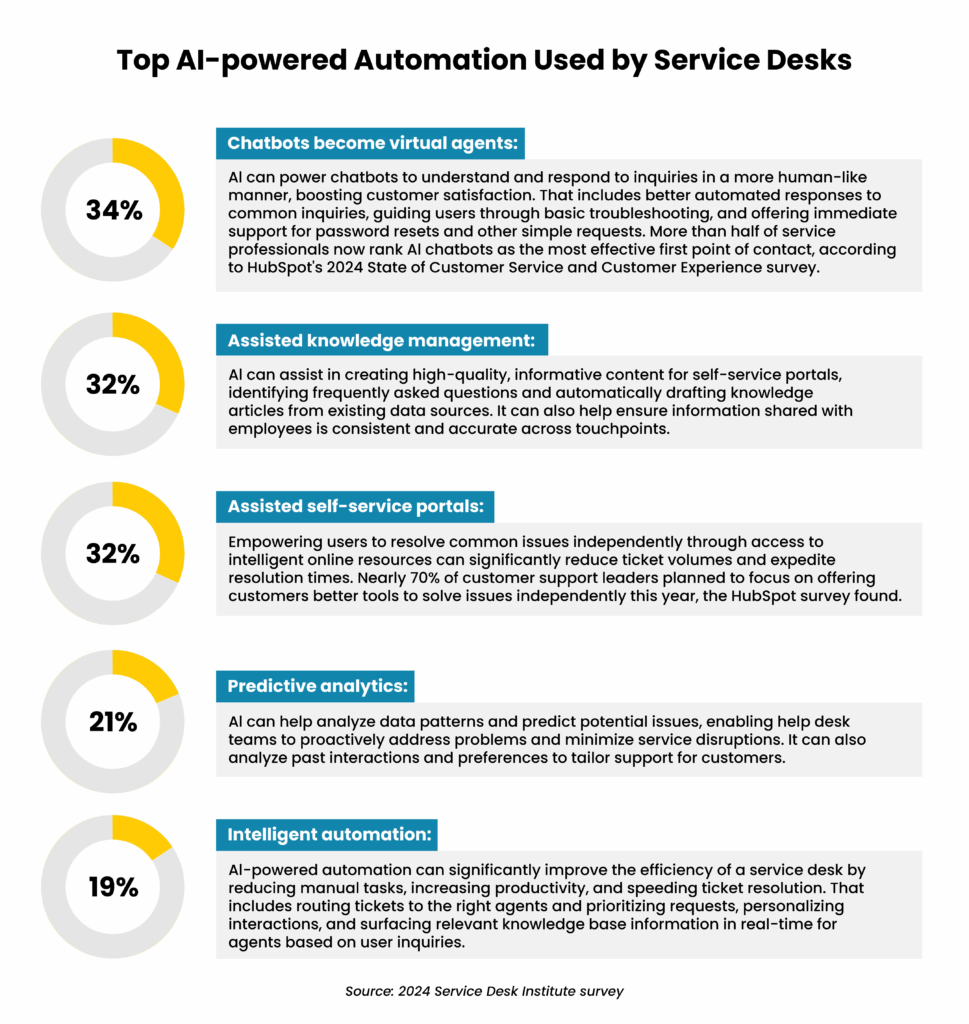
Agentic AI is changing the game even more, evolving service desk automations from simple task executors into fully autonomous entities capable of complex work. AI agents empower service desk personnel with enhanced communication, analysis, and problem-solving skills to deliver faster resolutions, anticipate user needs, and provide a more personalized and proactive support experience.
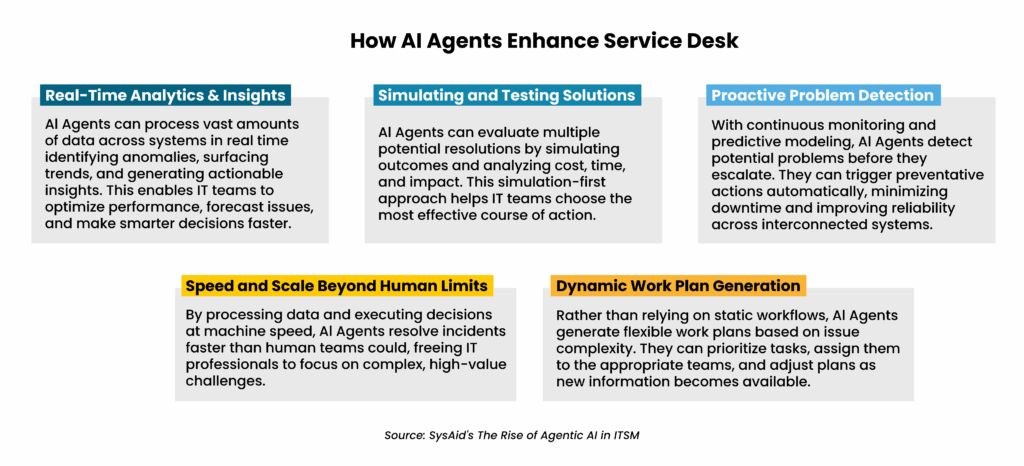
Still, barriers exist for organizations to be able to leverage intelligent automation successfully. Despite widespread use of AI by individual workers, most IT help desks are still not using AI/automation systematically, Ivanti’s 2025 Tech at Work report found – an indication that organizations use AI for more mundane tasks but still don’t “trust” these solutions to handle mission-critical work.
Other significant barriers for AI adoption include lack of high-quality data, challenges integrating with legacy systems, managing the high initial costs of implementation, and lack of skilled personnel – a factor we’ll discuss in more detail later.
5. XLAs over SLAs: Outsourced service desks delivering better employee experience
Today, many organizations are recognizing the importance of service desk for providing a happy employee experience. Traditional service-level agreements (SLAs) focus on metrics such as response times, resolution times, and uptime.
However, there is a growing realization that end-user experience can be unsatisfactory, even with rapid response times.
87% of IT leaders say experience-level agreements (XLAs) make it easier to understand where support needs to improve – ranking employee satisfaction as the top performance metric for gauging service quality.
Zendesk The New IT Playbook: Transforming IT Service with AI
An increase in employee satisfaction yields real business outcomes, such as higher retention, better productivity, and happier customers.
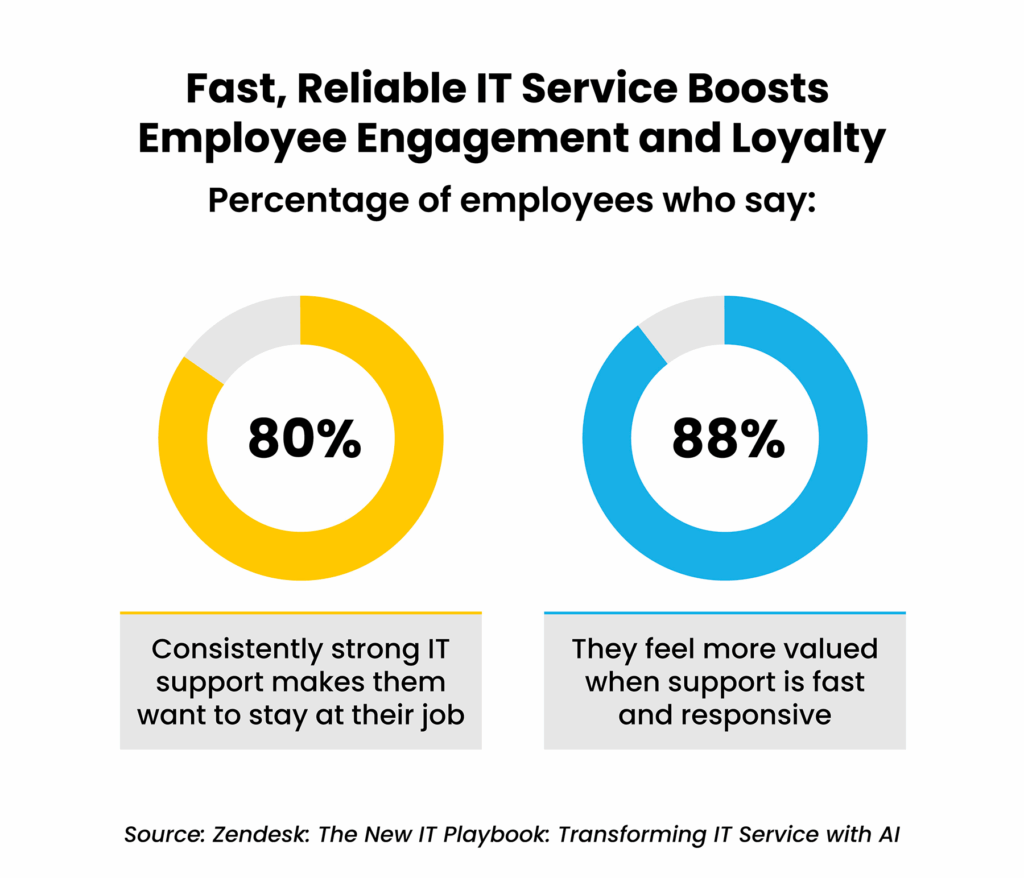
On the other hand, delays in IT issue resolutions can derail employee productivity. Each time a ticket is reassigned, end-user happiness decreases by eight points and users lose an average of two more hours of work time (HappySignals 2025 Global IT Experience Benchmark Report).
Yet, the same report also found that nearly two in three IT professionals say the demands of managing day-to-day IT operations are so overwhelming user experience often takes a back seat.
Outsourced help desks are emerging as a bright spot in this landscape. Over the last few years, outsourced service desks have become increasingly skilled at using experience data – and are achieving high satisfaction scores, the report found.
A high-quality service provider can bring the right mix of top service desk personnel, best practices, and AI automation tools to deliver faster resolutions, proactive support, and a consistently superior user experience.
6. Help desk industry trends reveal preference for nearshoring
While AI streamlines routine IT tasks, it will never replace people. The complexity of modern IT systems, cloud proliferation, and rising cyberthreats keep skilled support specialists in high demand – especially for complex troubleshooting and user-focused problem solving.
About 50,500 openings for IT support specialists are projected each year, on average, through 2034.
Bureau of Labor Statistics
But the persistent tech labor shortage present a significant challenge for delivering consistent and timely support, with help desks in the U.S. seeing high turnover rates averaging 42%, according to NICE WEM’s Contact Centers – From Attrition to Retention survey.
The latest service desk outsourcing trends show nearshoring emerging as an attractive opportunity to overcome these talent challenges. Latin America’s shared or similar time zones offer the real-time communication needed to resolve urgent IT issues, while less-saturated labor markets foster significantly less turnover, fewer delays, and effective, real-time support from top-tier talent.
In the Computer Economics report, IT leaders rank proximity as the #1 factor for choosing an IT outsourcing provider due to reduced operational challenges, easier management of data residency issues, and compatibility of language, culture, and time zone – even if a lower cost can be realized in more distant locations.
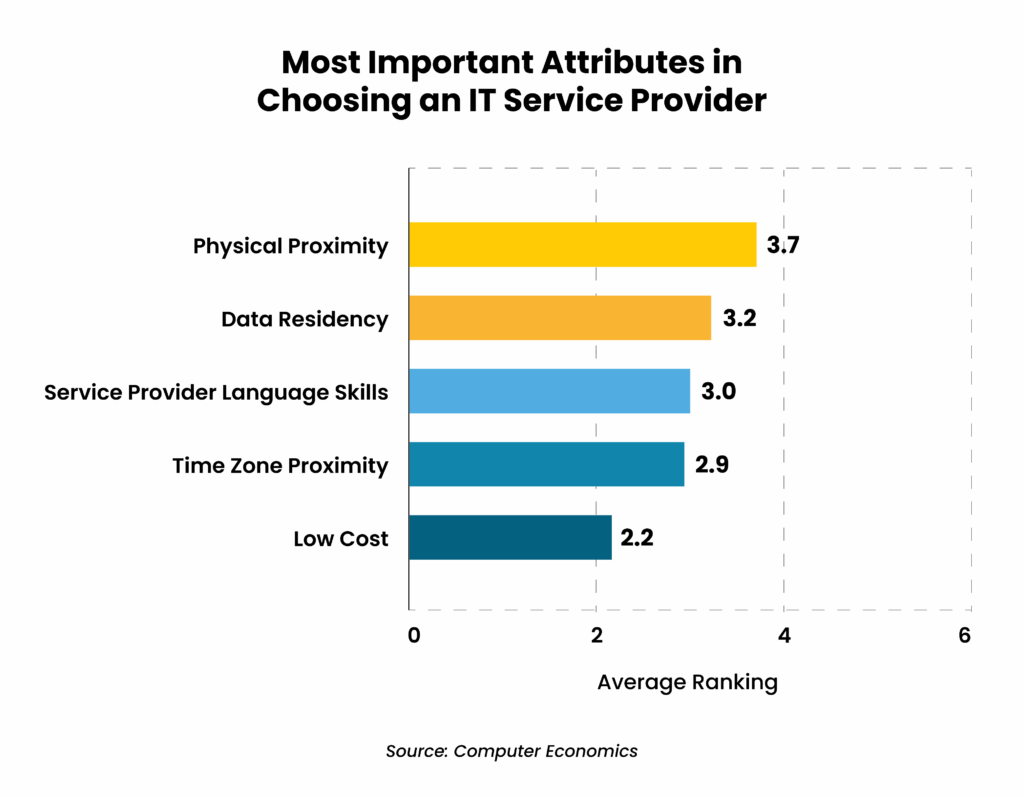
CBRE’s Scoring Tech Talent 2025 report ranks Latin America as the #1 up-and-coming tech talent market globally, spotlighting countries like Colombia, Mexico, and Costa Rica as top destinations. INSEAD’s latest Global Talent Competitiveness Index (GTCI), endorsed by the World Economic Forum, reinforces this message, showing how India’s talent competitiveness has decreased every year since 2020 as difficulty attracting and retaining talent in a highly competitive labor market leads to an increased skills mismatch for employers.
India ranks 103rd globally on the GTCI report, while top nearshore markets like Costa Rica, Colombia, and Mexico score significantly higher – coming in at 47, 72, and 74, respectively.
Performance outcomes tell the same story. The State of the GBS & Outsourcing Industry in Latin America report by SSON and Auxis found satisfaction levels at LATAM shared services organizations (SSOs) are significantly higher (87%) than Asia (53%), Europe (64%), and even North America (69%).
Not surprisingly, LATAM SSOs are running IT processes at nearly double the global rate (64% vs. 32%) – evidence of both their capability and rising strategic importance, the study found.
With the many advantages offered by nearshoring help desk, it is today a compelling alternative for companies seeking cost-effective, high-quality support solutions with minimized risks and enhanced collaboration opportunities providing a better ability to solve urgent IT issues.
7. Increasing adoption of a swarming support model for faster, better support
The traditional, three-tiered service desk structure – comprised of generalists, technicians, and subject matter experts (SMEs) – can create a bottleneck for complex service cases or major incidents, with each handoff introducing delays, increasing costs, and diminishing end-user productivity. As tickets escalate through levels, employee downtime rises from two hours to a whopping average of nine hours and 28 minutes! (HappySignals)
Efficient ticket routing and resolution is key to maintaining high levels of employee satisfaction and productivity. With that in mind, many help desk providers are adopting swarming for problems that need to be solved in real time.
Swarming is a modern IT support model that brings cross-functional experts together from the start to collaborate on solving IT incidents quickly. It provides better results for complex, time-sensitive, and cross-functional issues, where traditional tiered escalation leads to delays and customer frustration.
By fostering real-time collaboration and transparency, swarming leads to faster resolution, higher employee satisfaction, lower turnover of skilled agents, improved user experiences, stronger customer loyalty, and, ultimately, better renewal rates and margins.
13% of tickets drive 80% of lost productivity – indicating a small number of complex, time-consuming cases account for most employee downtime.
HappySignals 2025 Global IT Experience Benchmark Report
AI is further enhancing swarming models – intelligently routing issues to the right experts, surfacing collective knowledge, and optimizing skill utilization – truly bringing the principles of swarming to life while enabling swifter, smoother resolutions.
Net Promoter Scores of providers using swarming and single-tier support are 12.4 points higher than those who are not, the Technology & Services Industry Association (TSIA) found. Those using a swarming process also saw 5.4% higher contract renewal rates.
Why Auxis: Outsourcing your help desk for long-term success
Help desk outsourcing has proven its value as a successful strategy for delivering quality IT support without breaking the bank. The question is no longer if you should outsource your service desk, but how you structure it and which partner you trust to deliver.
Selecting a leading help desk nearshoring partner like Auxis can make all the difference in turning your help desk from a cost center into a strategic advantage. With Auxis, you get more than cost savings – you gain deep technical expertise, tailored AI automations, always-on 24x7x365 support, best practices, and access to the latest technology innovations.
That means faster resolutions, greater scalability, high-quality service, and a help desk that empowers your IT team to focus on what matters most: driving innovation and delivering exceptional employee experiences.
Want to learn more about how help desk services and nearshore outsourcing can support your business needs? Schedule a consultation with our help desk leaders today! Or visit our resource center to learn more help desk trends, strategies, and success stories.
Frequently Asked Questions
Why are more companies choosing IT help desk outsourcing today?
What are the benefits of using an outsourced help desk provider?
What should I look for when selecting an outsourcing IT help desk provider?
What role do AI and automation play in current service desk outsourcing trends?
What is the best way to evaluate outsourced help desk pricing?



